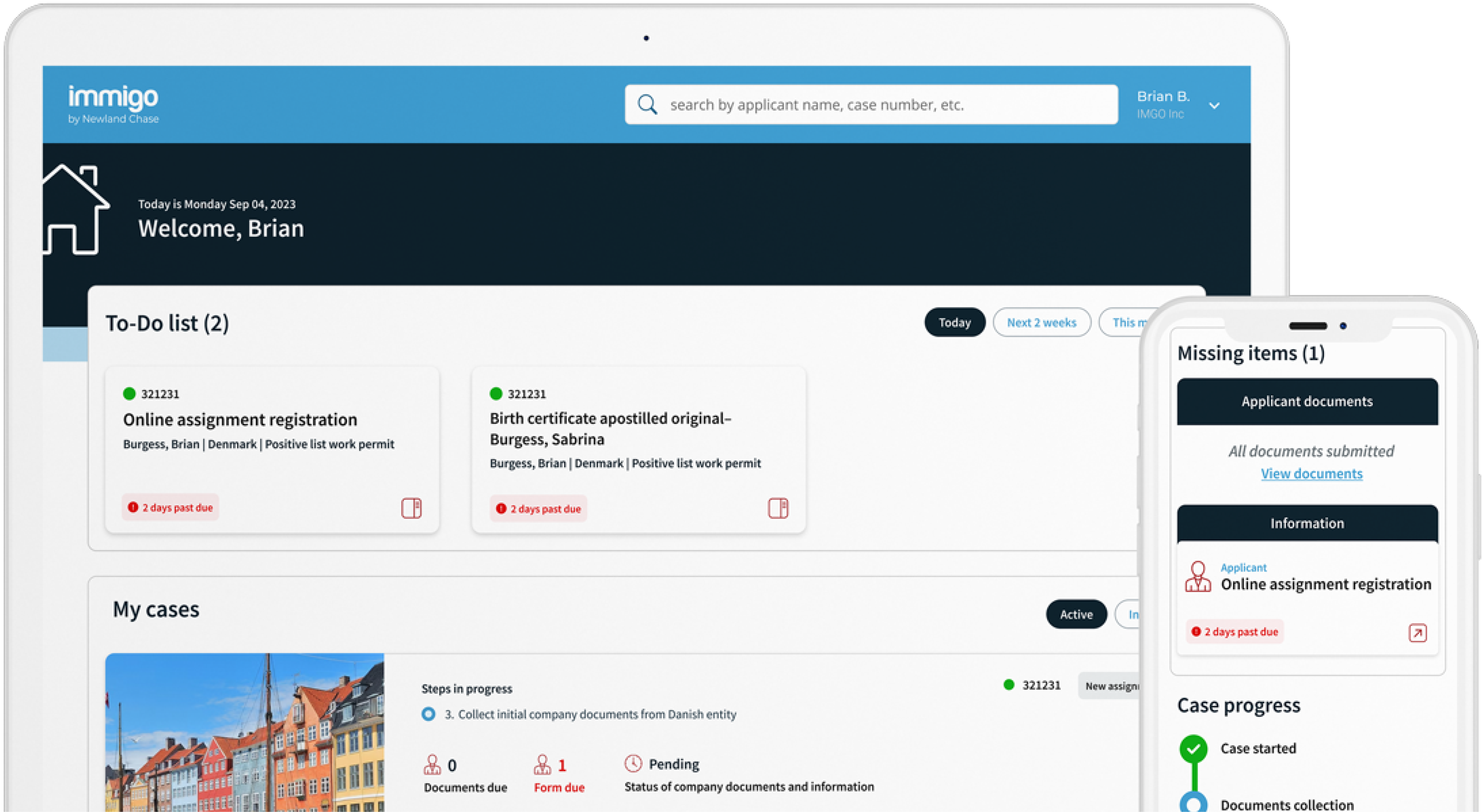Get The Visibility Your Company Needs
Reduce compliance risks and mobility costs while managing individual and project-related travel with ImmiSMART: the solution that unifies your travel and mobility programs.
UNITED STATES – What the USCIS Fee Increase Means for US Immigration
October 5, 2023
US Citizenship and Immigration Services (USCIS) of the Department of Homeland Security (DHS) has proposed a significant increase in immigration filing fees, affecting various forms and applications. The DHS posted the proposed rule in the Federal Register in January 2023. The proposed rule aims to help the agency offset operational costs, improve customer service operations by reducing case processing times, and maintain timely case processing to prevent future backlogs.
The changes come as USCIS struggles to handle the influx of asylum seekers and the impact of USCIS closures during the COVID-19 pandemic, which have strained their resources. Because of previous delays, including a 2020 proposed rule blocked by US courts, the current fee schedule dates back to 2016. Revenue raised from fees, which primarily fund the agency, is insufficient to cover the operating costs and federally mandated pay raises the agency faces.
How significant are the fee increases from US citizenship and immigration services?
The cost impact of the new fee structure is quite significant. Many applicants will face steep fee increases. For example, for I-485 applicants, the proposed fee increase will raise the cost of filing Form I-485 (Application to Register Permanent Residence or Adjust Status) from $1,225 to $1,540. Applicants requesting employment or travel benefits or those with children applying at the same time will also see significant increases.
The proposed rule introduces significant changes as well, such as integrating the biometric services fee with the main benefit fee and requiring separate filing fees for Form I-131 and Form I-765 when filed with an adjustment of status (Form I-485). The agency plans to shift the burden of costs onto those who can afford it while decreasing some fees or providing fee exemptions for individuals less likely to afford them, such as asylum seekers applying through the USCIS asylum program and victims of human trafficking or other crimes.
Who will feel the effects of the USCIS filing fees increase?
Eliminating the No-Cost EAD and Advance Parole
USCIS plans to stop waiving fees for adjustment of status applicants seeking employment authorization (Form I-765) or a travel document (Form I-131) with a pending I-485 application. The new fee schedule would charge separate fees for Forms I-485, I-765, and I-131, drastically increasing the cost for individuals adjusting their status to permanent resident. The total cost will rise to $2,820—a 130% increase.
Eliminating the I-485 discount for children
The proposed rule removes the reduced fee for children filing Form I-485 with a parent. Children must pay the same fees as adults under the proposed rule, representing a 105% increase over current fees.
Increased fees for family-based immigrant visa petitions
The proposed fee increase will also affect family-based immigrant visa petitions.
The fee for Form I-129F (Petition for Alien Fiancé) will increase by 35% to $720.
Form I-130 (Petition for Alien Relative) fees will rise by 53% to $820, making it more expensive for US citizens to sponsor family members for a green card.
Citizenship fee increases moderately
The fee for Form N-400 (Application for Naturalization) will increase to $760, a 5% increase. However, because the biometric service fee will be part of the USCIS filing fee, applicants aged 75 and older will see an effective fee increase of 19%.
Maintaining a Green Card will be less expensive, but Conditional Residents application fees will rise
Permanent residents will see a decrease in the fee to file Form I-90 (Application to Replace Permanent Resident Card), with the cost dropping from $540 to $465.
However, conditional residents filing Form I-751 (Petition to Remove Conditions on Residence) will experience a significant fee increase, rising from $680 to $1,195.
How will the proposed fee increase impact employers?
The proposed rule will significantly impact employers that sponsor foreign workers. The proposed fees may affect recruitment and retention strategies, business processes, and overall business operations. Employers should carefully consider how these changes affect their budgets and operations and make necessary adjustments to remain competitive in the global talent market.
Employers will feel the effects of the new fees in several ways, as the steep fee increases affect many forms and applications relevant to their operations.
Here are the key ways that the proposed fees will impact employers:
Higher costs for sponsorship
Employers who sponsor foreign workers for employment-based visas , like the H-1B, L-1, and O-1, will face higher costs due to the increase in filing fees. The proposed fee increase will affect employers sponsoring new visa applicants and those seeking to extend or adjust their current visas. Employers may need to reassess the financial feasibility of sponsoring foreign workers or consider absorbing the additional costs.
Impact on recruitment and retention
The new fee rule may make it more difficult for employers to recruit and retain foreign talent, especially if they pass on some or all of the additional costs to the employees. The increased costs could hinder their hiring and retention of skilled professionals, affecting their business growth.
Adjustment of status costs
Employers that assist employees in adjusting the status process (from a nonimmigrant visa to permanent residency) will face higher costs due to the increase in Form I-485 filing fees. The separate filing fees for Form I-131 (Application for Travel Document) and Form I-765 (Application for Employment Authorization) in conjunction with Form I-485 will also increase the overall cost for employers supporting the adjustment of the status process.
Green Card sponsorship
Employers sponsoring foreign nationals for green cards may see higher costs due to the increased fee for Form I-130 (Petition for Alien Relative). If employers choose to pass these fees onto their employees, it could discourage some potential applicants from pursuing permanent residency.
Consideration of alternatives
Due to the higher fees, employers may consider alternative visa categories that are less expensive or consider focusing on hiring US citizens or permanent residents to avoid the increased costs altogether.
Budget adjustments
Employers with many foreign employees may need to adjust their budgets to accommodate the higher fees. The higher costs could result in companies delaying or canceling other strategic business plans, such as hiring or expansion plans.
Impact on small businesses
Smaller companies with fewer resources may be particularly affected by the increased fees, as they may need help to absorb the higher costs of sponsoring foreign workers. The higher prices could affect their competitiveness in attracting and retaining global talent.
Nonimmigrant fees would increase for many categories
Until now, the Form I-129 filing fee across all visa classifications was $460. The Form I-129 fee change would affect all categories, including H-1B, H-2A/B, E, L-1, O, P, and TN.
In the new rule, the USCIS proposes charging different fees for each visa classification.
- H-1B fees would increase by 70% to $780.
- L-1 petition fee would increase by 201% to $1,385.
- E and TN petitions would increase 121% to $1,015.
The USCIS also proposes to increase H-1B electronic registration fees to $215 per registration from $10. That is a 2050% increase.
According to the agency, the fee hike results from a review of the cost of administering the H-1B registration system. But, overall, the new fee structure also aims to prevent misuse of the immigration and asylum program.
Steep increases proposed in EB-5 fees
The proposed rule would also significantly increase filing fees for EB-5 immigrant petitions.
- Form I-526 and Form I-526E fees (Immigrant Petition by Alien Entrepreneur/Regional Center Investor) would increase 204% from $3,675 to $11,160.
- Form I-829 (Petition by Investor to Remove Conditions on Permanent Resident Status) would increase 148% from $3,835 for most applications to $9,525 for those that require biometrics.
No increase to premium processing service
- The I-907 Request for premium processing for form I-129 requesting E-1, E-2, E-3, H-1B, H3, L (Including blanket L-1), O, P, Q, or TN nonimmigrant classification; or form I-140 requesting EB-1, EB-2, EB-3 immigrant visa classification would remain unchanged at $2,500.
- The I-907 Request for premium processing for form I-129 requesting H-2B or R nonimmigrant classification would still be $1,500.
There is also a concern that the proposed rule might increase administrative costs for employers wishing to file applications before any fee changes take effect.
USCIS fee increase by form for family-based immigrant applications
The proposed fee increase affects most forms, though some forms had no change and a few saw a slight reduction. The Federal Register has a full list of present and proposed fee increases and changes in Table 1 of the Proposed USCIS rule.
Below is a partial list of the proposed fee changes for some of the most commonly used family-based USCIS forms.
Current and proposed fee schedule
Form | Type | Current Fee | New Fee | $ Change | % Change
Form I-90 | Replace Permanent Residency Card (with Biometrics) | Current Fee $540 | New Fee $465 | Decrease $75 | -14%
Form I-129F | Alien Fiancé(e) | Current Fee $535 | New Fee $720 | Increase $185 | 35%
Form I-130 | Alien Relative | Current Fee $535 | New Fee $820 | Increase $285 | 53%
Form I-131 | Travel Document (with biometrics) | Current Fee $660 | New Fee $630 | Decrease $30 | -5%
Form I-131A | Carrier Documentation | Current Fee $575 | New Fee $575 | Difference $0 | No change
Form I-485 | Register Permanent Residence or Adjust Status | Current Fee $1,225 | New Fee $1,540 | Increase $315 | 26%
Form I-751 | Remove Conditions of Residence (with biometrics) | Current Fee $680 | New Fee $1,195 | Increase $515 | 76%
Form I-765 | Employment Authorization (with biometrics) | Current Fee $495 | New Fee $650 | Increase $155 | 31%
Form N-400 | Naturalization (with biometrics) | Current Fee $725 | New Fee $760 | Increase $35 | 5%
Form N-565 | Replacement Naturalization/Citizenship Document) | Current Fee $555 | New Fee $555 | Difference $0 | No Change
Form N-600 | Certificate of Citizenship | Current Fee $1,170 | New Fee $1,385 | Difference $215 | 18%
All proposed application fees listed include biometric services, if required. Some of these applications offer a discounted fee for forms filed online.
Why are some proposed fees for the same form different for online filing vs. paper filing?
The USCIS wants to encourage applicants to use online filing options, where available, to improve the efficiency of the submission and adjudication process. Paper filings have several disadvantages, including higher administrative costs to the agency in receiving, storing, and handling applications. Furthermore, information recorded on paper cannot be as effectively standardized or used for fraud, national security, information sharing, and system integration purposes. The USCIS has various forms available for online filing and case management.
When do the new immigration fees go into effect?
Earlier this year, the DHS extended the comment period on the proposed USCIS rule to mid-March 2023. The docket now shows a final planned final action for 2024.
After reviewing public comments, DHS may modify the rule, resubmit for a further public comment period, or publish a final rule with no further comments requested. That could happen at any time, likely towards the end of 2023.
The DHS will set the effective date of new fees once the final rule is published. Those who might be affected by the final fee rule should try to file their applications before the end of 2023, as soon as possible.
FAQs on the USCIS fee increases
How much is the naturalization fee in 2023?
The current fee for naturalization (Form N-400) is $640, with a reduced-fee application, available for specific circumstances, of $320. Those costs will remain in effect until the new rule is final. The USCIS’ new proposal for Form N-400 (Application for Naturalization) is a fee of $760, with a reduced fee for specific circumstances of $380. It’s important to note that in both cases the new fees include biometric services.
When does the new filing fee go into effect?
While the rule is under review, it’s difficult to predict when the filing fees will go into effect. However, the DHS has set a final action for 2024 in the docket. Wherever possible, applicants should file before the end of 2023.
Helpful resources from the US federal government
- US Citizenship and Immigration Services Fee Schedule and Changes: Federal Register
- Forms Available to File Online: USCIS
- Proposed Fee Rule FAQs: USCIS
Further guidance on USCIS fee increases from Newland Chase
The proposed fee increases are intended to help the agency offset operational costs and improve case processing times. However, the fee increase will significantly affect I-485 applicants, family-based immigrant visa petitions, businesses, and others, making it more expensive for individuals and families to pursue immigration benefits in the United States.
If you may be affected by the future fee structure, now is the time to file the necessary paperwork and avoid higher costs. Contact Newland Chase’s experts for guidance tailored to your organizational or personal requirements.




